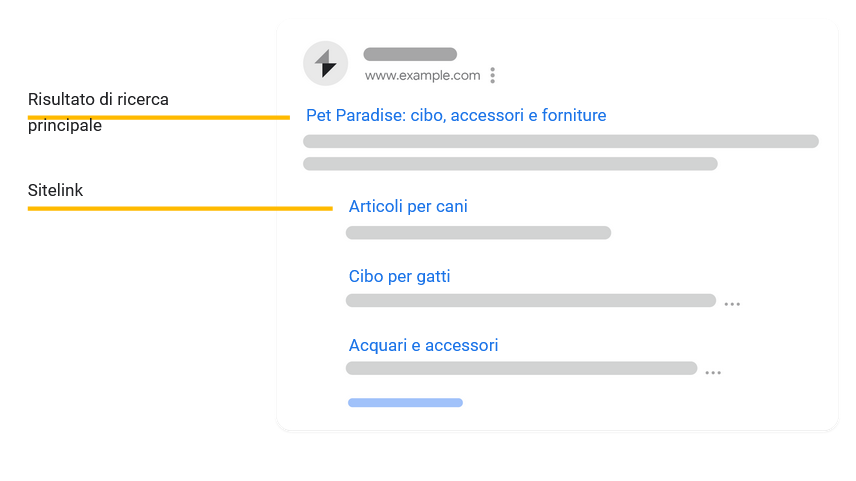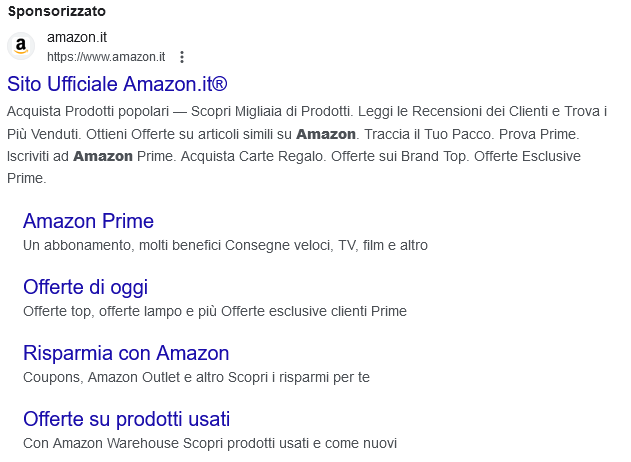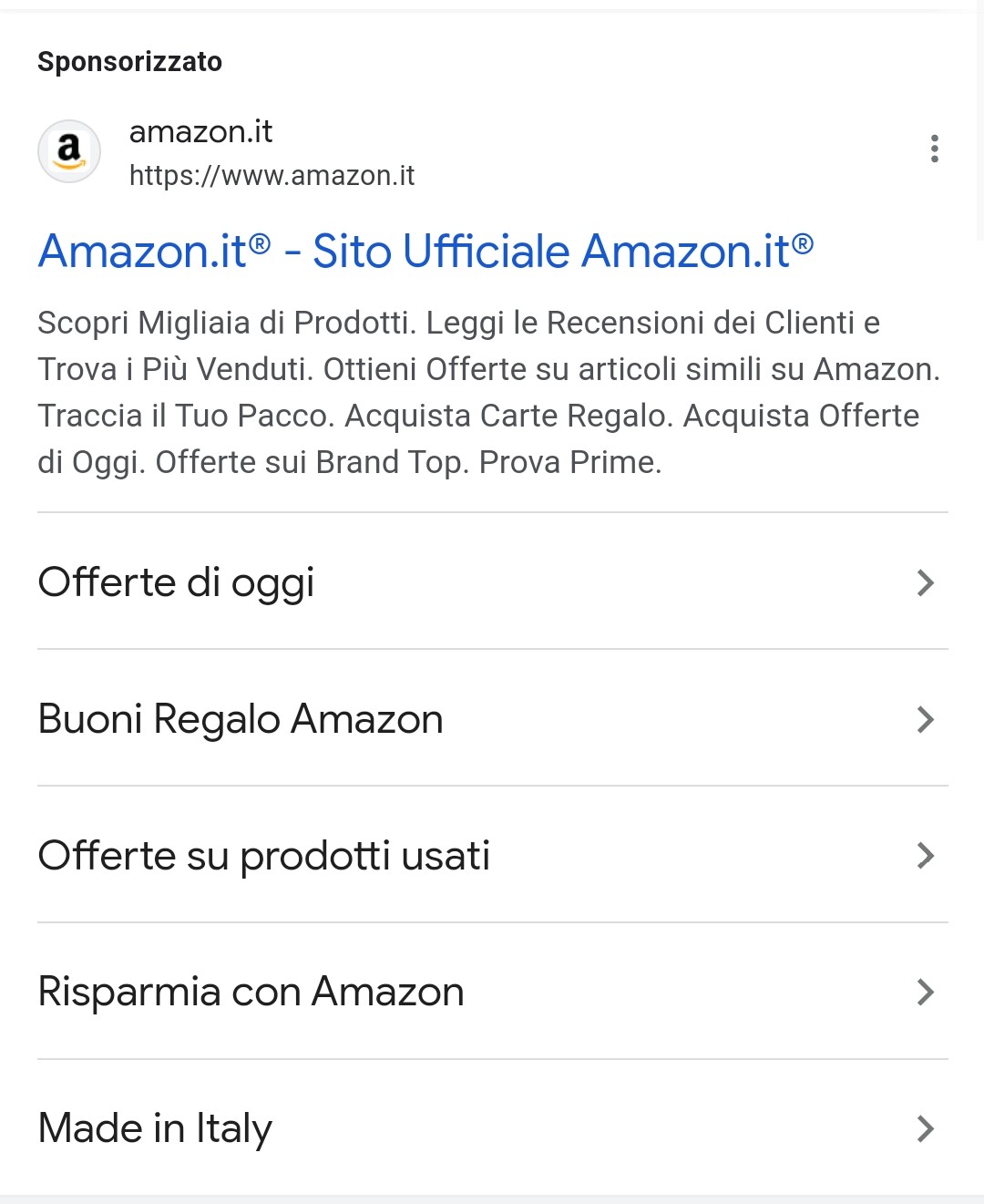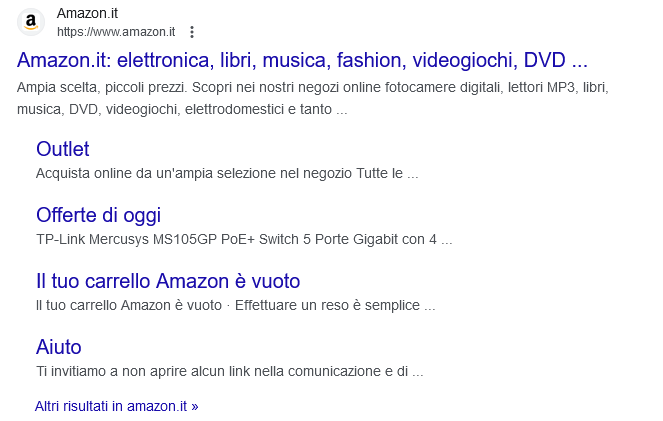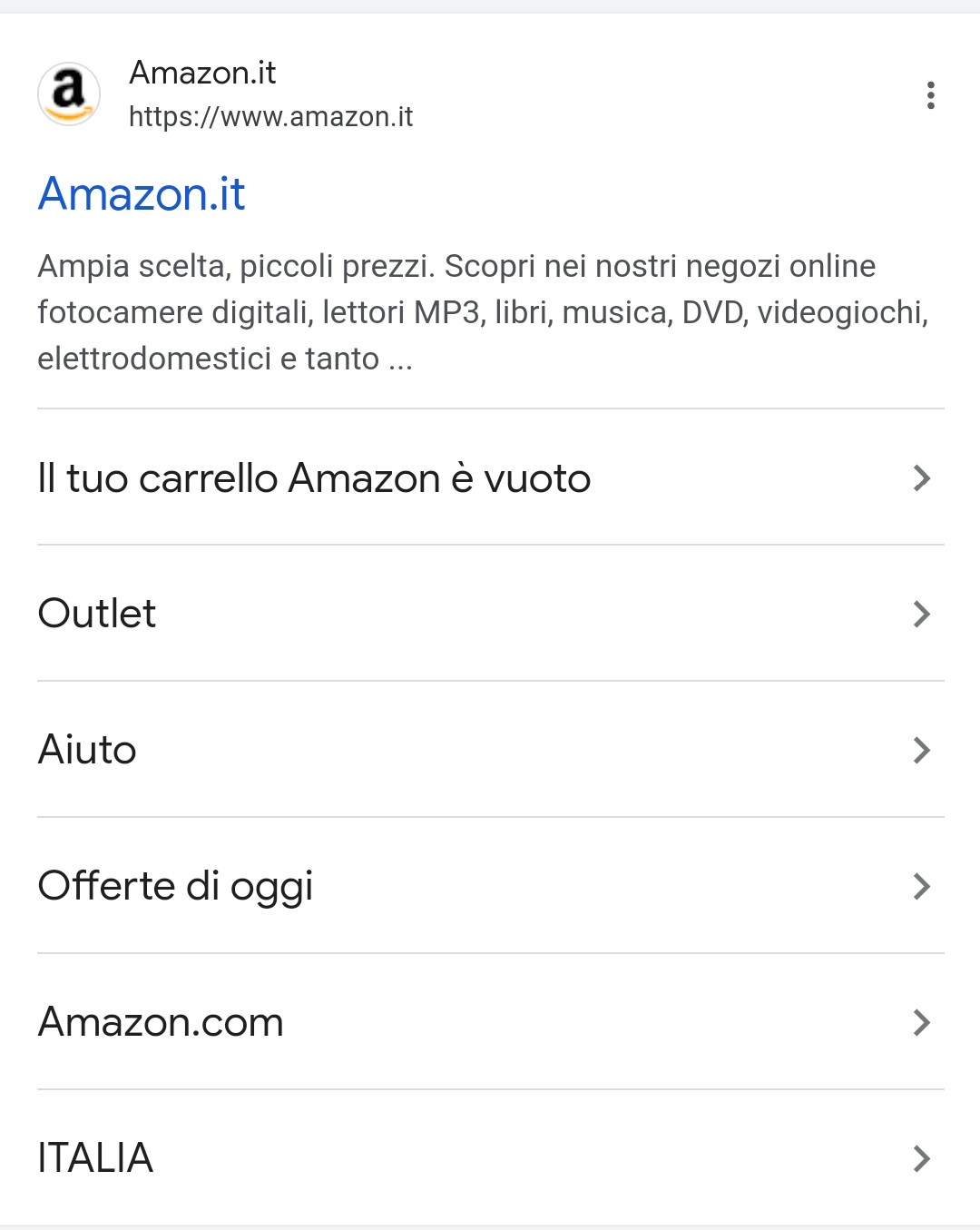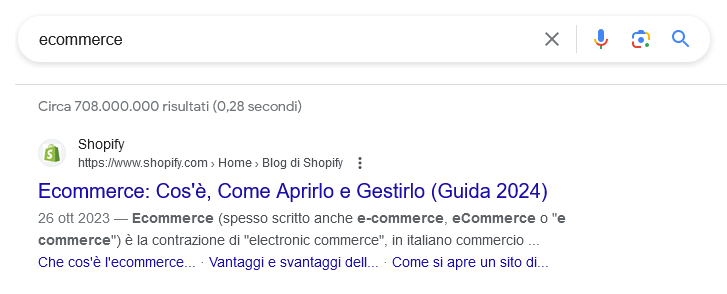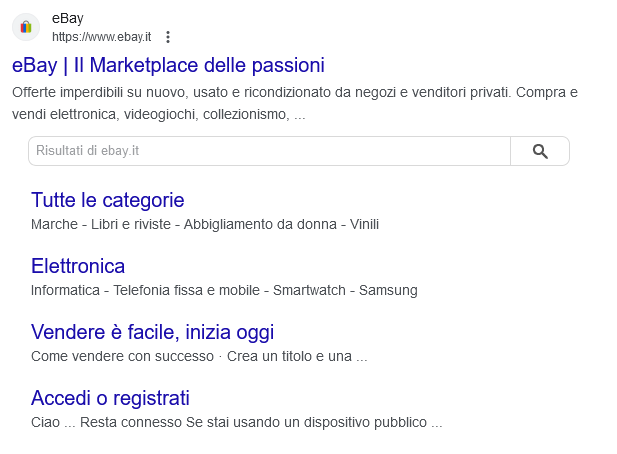How to check and delete sitelinks on Google, the complete guide
They are called sitelinks, and they are the links that appear in SERP under some Google search results that help users enter directly into a section or a specific page of that site: they can be great to increase the CTR, but they are automatically generated by algorithms and, therefore, can point to Urls not very useful for business. So let’s find out what Google’s sitelinks are, how they can be managed and, above all, what tools and techniques we have available to remove unwanted ones and direct the search engine to more profitable addresses.
What Google’s sitelinks are
Sitelinks are a feature offered by Google that manifests itself in the form of additional sub-links that appear below the main result of a search, usually when searching for a brand or organization name.
These additional links lead to other pages or sections of a page that Google considers relevant and useful within the same domain, positioned as the first search result, while they do not appear for other subsequent positions.
Keep your site under control
Sitelinks are available in both desktop and mobile search results and are automatically selected by Google’s algorithm based on relevance and site structure.
The types of sitelinks: what are site links on Google
Google first introduced sitelinks in 2005 for desktop search results, with the goal of helping users navigate more easily and quickly to relevant information by offering shortcuts that save time when searching for the most useful destinations.
By directing users to specific website pages, Google creates a “fast lane” of quick access to the information they are looking for.
Initially, sitelinks were only available to a small number of websites and were much more limited, consisting of a single line of only four links, but before long Google made this feature potentially available to all websites and then continued to improve and expand it.
For example, in 2011 it made full-size links with a URL and a line of snippet text (like other results); in 2012 it introduced automatic sitelinks, which are automatically generated based on the website content and the user’s search query; and then again it extended sitelinks to mobile searches.
We currently recognize the following types of sitelinks that can appear in SERPs:
- Sitelink Ads (paid sitelinks)
Already known as “adwords sitelinks,” these are as the name suggests paid sitelinks that appear in Google Ads. They look virtually identical to organic sitelinks, with the one and only major difference being that their creation and appearance is under total control of the advertiser or site owner, who can then set the text and URLs that appear in the ad snippets.
They can appear either in the “inline” format or in an extended version, as embedded links with short text description.
- Organic sitelinks
Much broader are the variants of organic sitelinks, that is, those automatically generated by Google, at no expense to the site that “benefits” from them – which, however, also has no particular control over the content and pages that are shown (just compare the list of ADS sitelinks specified by Amazon with the list of organic sitelinks for the same domain, which point to pages that are evidently less strategic for the ecommerce giant). They appear only if Google believes that the sitelinks on our site are relevant and useful for the user’s query, and if the crawlers are able to identify valid sitelinks by analyzing the structure of the site itself.
In most cases, they are generated for branded queries and can have up to six “extra” results to other pages on the site.
This list includes:
- Standard sitelinks
This is the most common form of organic sitelinks, those that appear “naturally” on search results pages, usually in terms of branding, and contain up to six sitelinks to different pages on a single website.
They appear as a list of links below the main result; each sitelink has a title, which is often the title of the landing page, and may include a brief description that provides additional context about the topic of the landing page. These sitelinks help users quickly reach the most important or popular sections of a site, and they also help users in deciding whether that page is relevant to their search.
These organic sitelinks may link to specific pages on the website-such as the “About Us” page or the “Contact Us” page-or to specific sections of the website, such as the “Products” category or the “Blog” section.
On rare occasions, for some websites with high authority and clear structure, Google may show expanded sitelinks that occupy a significant portion of the search results space. These sitelinks can include categories, subcategories, and even images, providing an almost complete overview of the site directly from the SERP.
- Inline sitelinks
These are sitelinks in a compact format that appear in some cases, especially when space is limited or for search results on mobile devices.
These sitelinks consist only of the short title and usually have no description, a more concise form that is precisely to accommodate smaller screens and cleaner viewing.
- Sitelink search box
The sitelink search box is really a small search bar that allows the user to perform immediate and quick searches within the site or an application directly from the SERP, implementing real-time suggestions and other features. The sitelink search box is especially useful for sites with a large volume of content because it helps users quickly find what they are looking for without having to navigate through the site structure.
This search box is based on Google Search technology and is automated, but we can provide explicit information by adding “WebSite” structured data, which helps Google better understand the site.
In addition, in Search Console we can monitor various data related to this feature, such as the presence of errors preventing display or the list of valid elements recognized by Google.
- Sitelinks for Mobile App
If a site has an associated mobile app, Google might show a sitelink that directly directs to the relevant app store for downloading the app. This type of sitelink is useful for promoting the use of mobile apps and providing quick access to users who prefer to interact with content via an app.
The characteristics of organic sitelinks
As Google’s guide explains, sitelinks in results appear only when deemed useful to the user and are automated-this may change in the future as the search engine is “working relentlessly to improve sitelink algorithms and, in the future, suggestions from site owners may be integrated.”
Sitelinks will not appear if the structure of the site does not allow the algorithms to identify valid sitelinks or if Google believes the site’s sitelinks are not relevant to the user’s query.
How to influence sitelinks on Google
The appearance of this feature in SERP and the choice of Urls is automated by algorithms, as seen, but that doesn’t mean that site owners and SEO do not have tools available to influence sitelinks and try to steer Google towards more useful pages for the business.
Several studies, then, have highlighted a number of factors that can affect the sitelinks shown in Google’s organic search results:
- Site structure. Site architecture plays a role in the way sitelinks appear: for example, with a flat architecture Google will have to use other signals.
- Internal links. The way pages link to other pages and the anchor text used will affect the sitelinks, as seen, and also the location where the links are located on the page and breadcrumbs. The internal linking strategy must also support the hierarchical structure of the site.
- Do not block robots’ access. It may seem obvious, but it should be made clear that we need to allow crawlers to index all pages of the website to get sitelinks.
These insights are “confirmed” by the aforementioned Google guide, which explicitly mentions among the best practices for improving sitelink quality:
- Use text in the page title and headers that is informative, relevant and compact.
- Create a logical site structure where users can easily navigate.
- Create links to important pages from other relevant pages on the site, and use anchor text of internal links that are concise and relevant to the page they link to.
- Avoid repetition in content.
How to remove a site’s sitelinks
Greater control there is in the opposite cases, however, when that is, we are not interested-for whatever reason-in having sitelinks related to our site appear.
In the past, until 2016, there was a special tool to remove unwanted sitelinks that appeared in SERPs, present within the old Google Webmaster Tools suite, but today we still have some options to communicate our preferences to the crawlers.
Specifically, if we wish to remove a sitelink we can delete the page from the site or use a noindex tag; if instead we wish to avoid the appearance of the sitelink search box we can set a robots meta tag “nositelinkssearchbox” to the home page, a specific statement that precisely tells Googlebot to disable this feature.
4 techniques to better manage sitelinks
An article by Mindy Weinstein instead takes us to the discovery of four techniques that can help us to better control the sitelinks that appear in SERP, to avoid the appearance of non-strategic URLs and try to convince the algorithm to show instead those that are more useful for our goals.
These are not tricks or absolute methods, because the choice remains automated, but best practices that, based on the author’s experience, can help to achieve the goal and generally work.
- Identifying the internal link that brings you the unwanted sitelink
If the organic sitelink has a URL we do not want, we must first scan the site to determine which pages link to this URL we want to remove.
Once we get the list of pages, we will intervene to review and update the anchor text and internal links that point to that unwanted sitelink, and then we will send the pages back to Google Search Console. After a few days, we should see updated sitelink in SERP.
- Do not index the page appearing among sitelinks
We have already said that Google does not show among sitelinks a page with noindex, but obviously this is an extreme approach, which we can only adopt if the page that appears in sitelinks is not useful to index.
Using noindex indiscriminately, in fact, means removing the page from search results and substantially giving up organic traffic.
So, only if the URL that appears among the sitelinks refers to a page that should not be indexed, obsolete and no longer used, can we consider the “noindexing”, which should remove the unwanted sitelink from the SERPs.
- Using descriptive Anchor Texts and Alt Texts
To try and increase the chances of placing a specific URL among sitelinks, we must work on optimizing anchor texts and alt texts, which must be descriptive, concise and unique.
- Creating a clear site structure
Weinstein also recommends taking care of the site structure to improve sitelinks, trying to show a clear hierarchy of pages.
Ideally, says the expert, the site should be “set up so as to start with a more general topic (e.g., main page) and enter a more specific topic (e.g., child page)”, as in the example structure Car > Ford > Mustang .
Internal linking is an important part of the website structure and we also know that it affects sitelink.
Sitelink SEO: the benefits of this feature
In general, sitelinks are a good SEO opportunity because they allow a site to take up more space in SERPs and users to more easily access the pages they are interested in.
Although we do not have direct control over these links, there are tips and best practices that allow us to remove unwanted sitelinks from SERPs and also improve what appears in Google search results. If optimized, therefore, they can be useful in ensuring greater visibility in search results for our domain: additional links take up more space and give the site more prominence than other search results.
Take control!
In concrete terms, they can improve organic CTR and help users find what they are looking for even more quickly within the website, which might be hidden within a different page or pages.
Even one-line sitelinks, which are less obvious than other more extensive formats, still contribute to a more remarkable result, in the same way that other SERP elements such as rich snippets for ratings, prices, and so on can do.
The presence of sitelinks increases the likelihood that users will find exactly what they are looking for without having to leave the site to consult other sources.This is particularly relevant because it can lead to a reduction in the bounce rate, which is the percentage of visitors who leave the site after viewing only one page. With sitelinks, users have the ability to jump directly to the page or section they are interested in, without having to navigate through the menu or scroll through long pages. This not only improves the user experience, but also increases the chances of conversion or deeper interaction with the site.
In summary, sitelinks enrich a site’s search result by giving users a direct path to the information or pages they are looking for. This benefit extends to all types of sitelinks, including those that appear within the pages themselves, facilitating intuitive and satisfying navigation.



